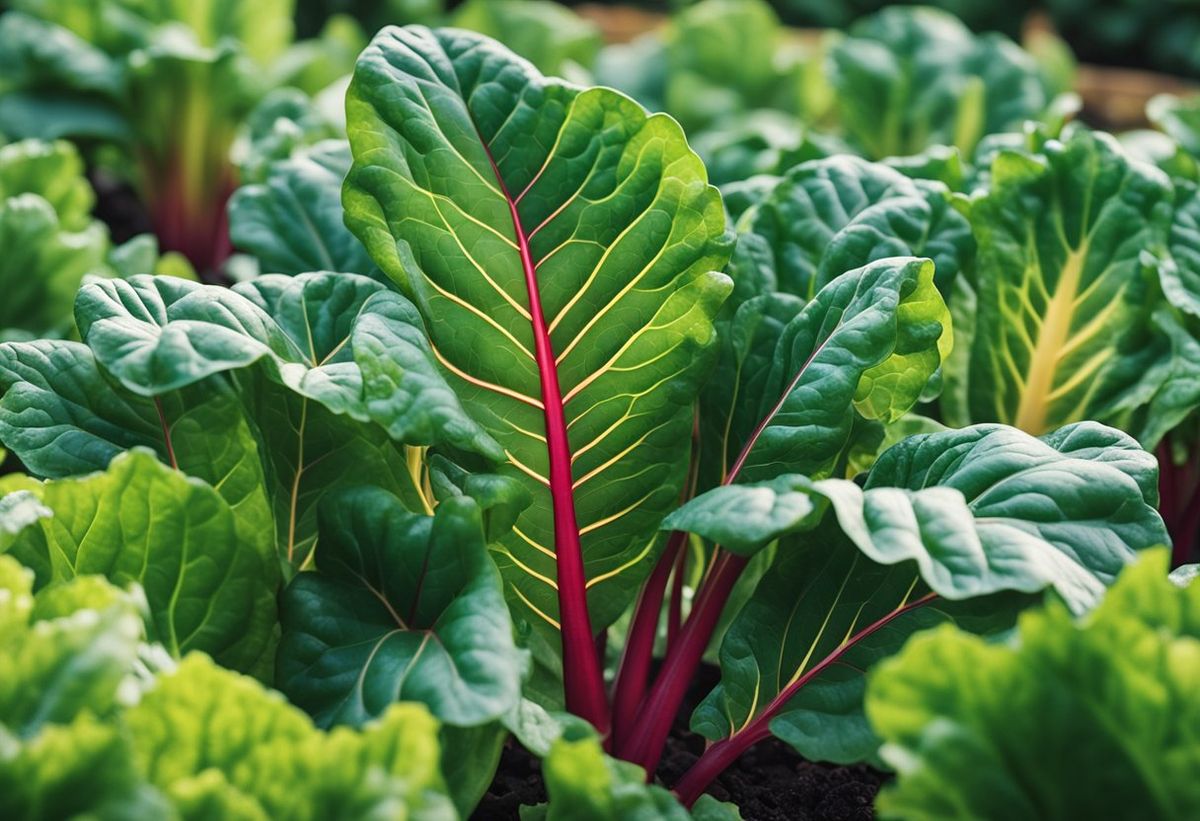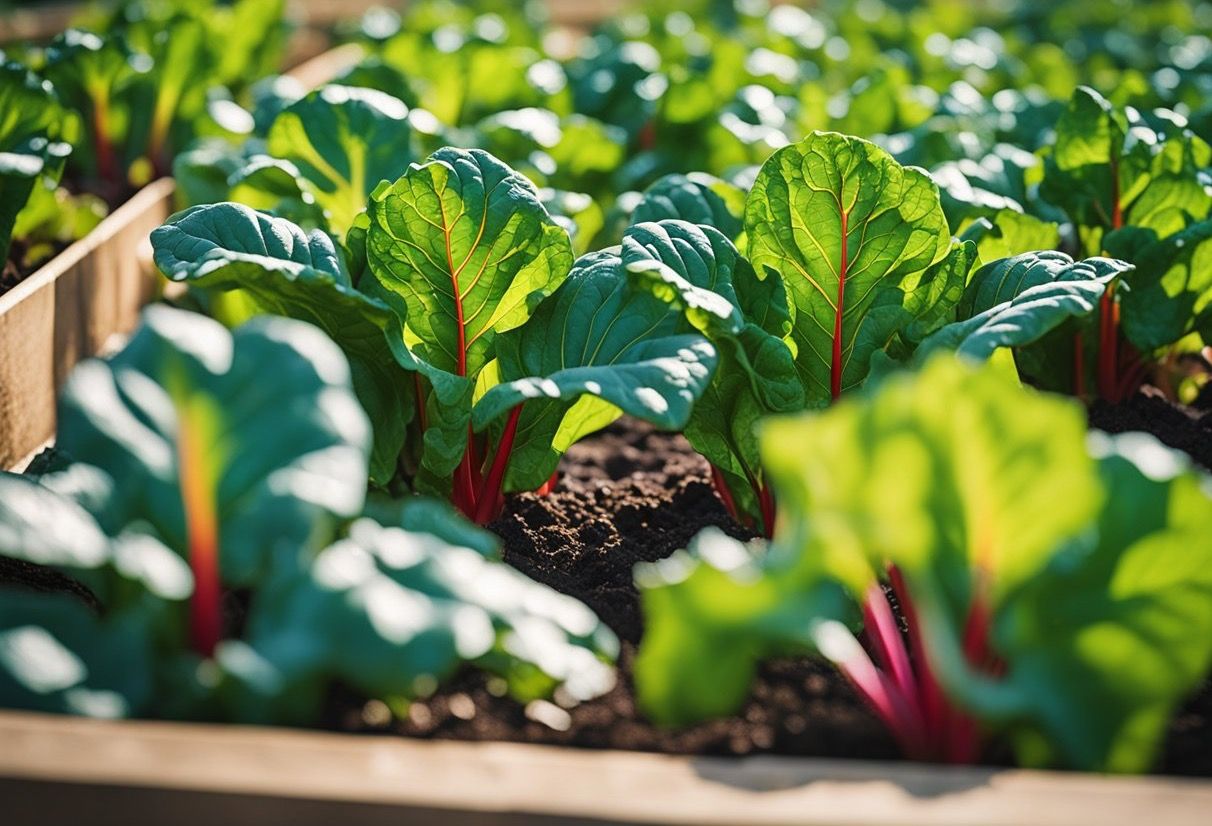How to Grow Swiss Chard
Swiss chard is a colorful, nutritious, and versatile leafy vegetable, perfect for vibrancy and flavoring your garden and meals.

Table of Contents
Its easy-to-grow nature makes it an excellent choice for novice and experienced gardeners.
To successfully cultivate Swiss chard, choose a location with full sun to part shade and ensure the soil is organically rich and well-draining.
Aim for a slightly acidic soil pH between 6.0 and 8.0, ideal for its growth.
With the right conditions and care, you'll be well on your way to reaping the rewards of this beautiful and nutritious leafy green.
About Swiss Chard

Swiss chard (Beta vulgaris var. cicla) is a leafy green vegetable that is often upstaged in gardens by its close cousins spinach and beets.
This biennial plant (meaning it completes its life cycle in two growing seasons) is extremely easy to grow and is part of the beet family.
Swiss chard offers a variety of vibrant colors, with some varieties showcasing beautiful rainbow shades on its stems.
It is visually appealing and a nutritional powerhouse, high in vitamins A, C, and K, as well as minerals like copper and magnesium.
Native to the Mediterranean region, Swiss chard can be a great addition to your garden and your salad.
Growing Swiss Chard
Spring
Start planting Swiss chard seeds indoors 3 to 4 weeks before the average last frost date.
Use fertile, well-draining soil and sow seeds about 1/2 to 3/4 inch deep.
When seedlings reach 3 to 4 inches tall, transplant them outdoors, placing them 4 to 8 inches apart in a location with full sun or partial shade.
Summer
Swiss chard can tolerate heat, so planting during summer is possible.
In late summer, sow seeds directly in the garden or containers, maintaining a depth of 1/2 to 3/4 inch.
Space seedlings 4 to 8 inches apart and ensure they receive adequate sunlight to prevent bolting.
Fall
To grow Swiss chard in the fall, plant seeds or seedlings in a location with full sun or partial shade, ensuring they receive enough light and warmth for proper growth.
As temperatures drop, keep an eye on the plants and apply mulch to protect them from frost and freezing.
Chard will tolerate light frost, but mulching helps extend the growing season.

Caring for Swiss Chard
Sun and Temperature
Swiss chard thrives in both cool and warm weather. Ensure your plants receive full sun to partial shade, with at least 4-6 hours of sunlight daily.
The temperature should be maintained at around 50°F (10°C) for germination, but the plant can grow in a broader range of temperatures afterward.
Adjust your planting schedule based on the season and your area's climate.
Water and Humidity
Water your Swiss chard plants consistently, keeping the soil moist but not waterlogged.
Regular watering is essential, but be cautious of over-watering as it may lead to root rot.
During hot and dry spells, increasing the watering frequency is necessary. Monitor the humidity level and water if the soil feels dry.
Soil
Swiss chard prefers well-draining soil with a neutral pH of around 6.0 to 7.0. Adding compost or organic matter can improve soil fertility and structure.
Ensure your planting containers have drainage holes to avoid standing water, which can harm the plant's roots.
Fertilizer
Utilize a balanced fertilizer or compost to provide essential nutrients like nitrogen, phosphorus, and potassium.
Apply fertilizer every 4-6 weeks during the growing season for optimal growth.
Repotting
Swiss chard can be transplanted after germination, spacing seedlings around 4 to 8 inches apart.
If plants become overcrowded, you can transplant them to larger pots or thin them by cutting the excess plants without disturbing the remaining plants.
Pruning and Propagation
Prune older or wilted leaves to stimulate new growth and keep your Swiss chard looking its best.
Regularly harvest mature leaves, but avoid removing more than one-third of the plant at a time to maintain its health and productivity.

Troubleshooting Plant Problems
Growing Problems
If your Swiss chard is not growing, check the soil's pH level, which can affect nutrient availability for the plant.
The optimal pH for Swiss chard is between 6.0 and 7.0.
Another reason for poor growth could be insufficient sunlight, so ensure your Swiss chard receives at least 5 to 7 hours of direct sunlight per day.
Pests and Diseases
Swiss chard can be affected by pests like slugs, insects, and deer.
Place barriers such as copper tape or diatomaceous earth around your plants to prevent slugs.
Insects can be controlled with insecticidal soap or neem oil. To discourage deer, use physical barriers like tall fencing.
Diseases like leaf spots can occur in Swiss chard, causing brown to gray spots on leaves.
Remove affected leaves, increase plant spacing to improve air circulation, and avoid overhead watering to manage leaf spots.
Companion Planting
Planting Swiss chard near leafy greens like lettuce and spinach can improve overall garden health.
These plants have similar growth requirements and can be planted together in the same bed.
Additionally, marigolds and onions can help repel pests like insects, slugs, and deer.
Avoid planting Swiss chard near beans or corn, as they have different nutrient requirements and can hinder each other's growth.
Conclusion
Swiss chard is an excellent addition to your garden, providing nutrition-packed leaves and crunchy stalks throughout the growing season.
The plants thrive in full sun and well-drained soil, making them relatively low-maintenance as long as gardeners provide consistent care.
Harvesting Swiss chard can be done by cutting or snapping individual mature leaves, allowing delicious continuous production of nutritious greens ideal for tossing in salads or sautéing for a side dish.
Embrace this leafy, glossy green – armed with these tips, you'll soon enjoy a successful and flavorful harvest.
Frequently Asked Questions
What is the ideal planting depth for Swiss chard?
Plant Swiss chard seeds about 1/4-1/2 inch deep in the soil for optimal growth. Space 8-10 seeds per foot with 18 inches between rows.
How often should Swiss chard be watered?
Water your Swiss chard regularly to keep the soil moist but not soggy. In hot, dry weather, you may need to water more frequently.
What are the best companion plants for Swiss chard?
Swiss chard grows well with plants like beans, onions, and tomatoes. Avoid planting it near cucurbits or corn, as they can inhibit Swisschard growth.
When is the optimal time to harvest Swiss chard?
Swiss chard can be harvested when leaves are mature and tender, typically 50-60 days after planting. You can also harvest young leaves for a tender, baby leaf option.
What type of fertilizer is suitable for Swiss chard?
A balanced fertilizer, such as a 10-10-10 or 14-14-14 mix, will provide adequate nutrients for Swiss chard.
Apply the fertilizer to package instructions before planting or as a side dressing during the growing season.
Can Swiss chard be grown in raised beds?
Yes, Swiss chard can be grown successfully in raised beds. Ensure that the soil is well-draining and has a depth of at least 6 inches for proper root growth.


